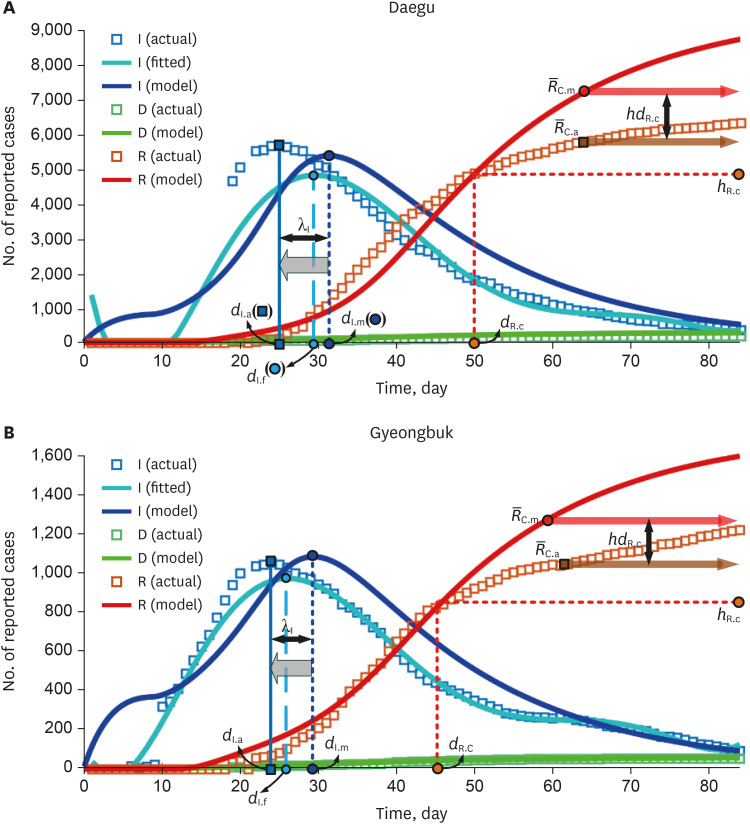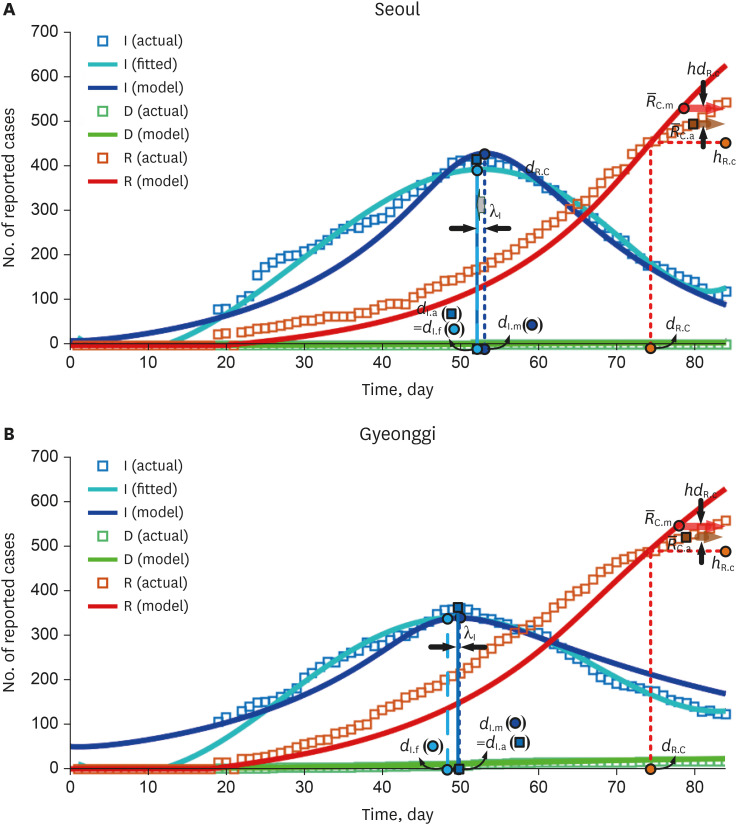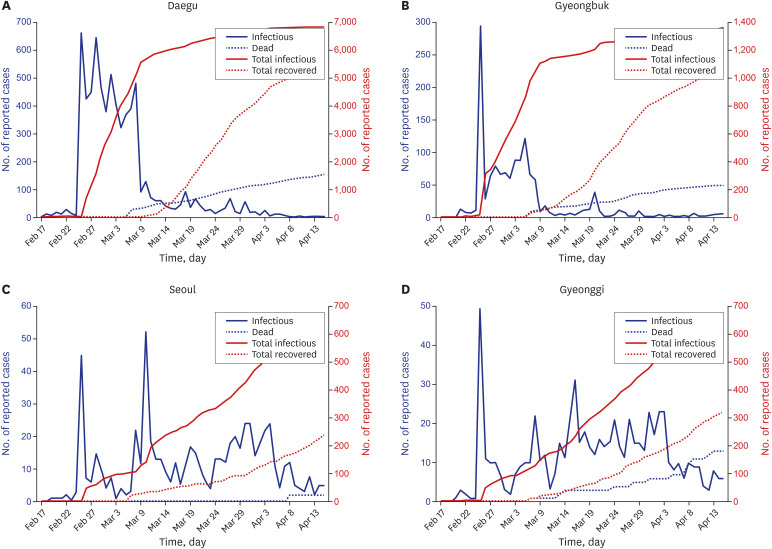J Korean Med Sci.
2020 Aug;35(34):e317. 10.3346/jkms.2020.35.e317.
Mass Infection Analysis of COVID-19 Using the SEIRD Model in DaeguGyeongbuk of Korea from April to May, 2020
- Affiliations
-
- 1Daegu-Gyeongbuk Research Center, Electronics and Telecommunications Research Institute, Daegu, Korea
- KMID: 2505729
- DOI: http://doi.org/10.3346/jkms.2020.35.e317
Abstract
- Background
The novel coronavirus (coronavirus disease 2019 [COVID-19]) outbreak began in China in December last year, and confirmed cases began occurring in Korea in mid-February 2020. Since the end of February, the rate of infection has increased greatly due to mass (herd) infection within religious groups and nursing homes in the Daegu and Gyeongbuk regions. This mass infection has increased the number of infected people more rapidly than was initially expected; the epidemic model based on existing studies had predicted a much lower infection rate and faster recovery.
Methods
The present study evaluated rapid infection spread by mass infection in Korea and the high mortality rate for the elderly and those with underlying diseases through the Susceptible-Exposed-Infected-Recovered-Dead (SEIRD) model.
Results
The present study demonstrated early infection peak occurrence (-6.3 days for Daegu and -5.3 days for Gyeongbuk) and slow recovery trend (= -1,486.6 persons for Daegu and -223.7 persons for Gyeongbuk) between the actual and the epidemic model for a mass infection region compared to a normal infection region.
Conclusion
The analysis of the time difference between infection and recovery can help predict the epidemic peak due to mass (or normal) infection and can also be used as a time index to prepare medical resources.
Keyword
Figure
Cited by 2 articles
-
Towards Telemedicine Adoption in Korea: 10 Practical Recommendations for Physicians
Hun-Sung Kim
J Korean Med Sci. 2021;36(17):e103. doi: 10.3346/jkms.2021.36.e103.Year-Long Trend in Glycated Hemoglobin Levels in Patients with Type 2 Diabetes during the COVID-19 Pandemic
Jonghwa Jin, Seong Wook Lee, Won-Ki Lee, Jae-Han Jeon, Jung-Guk Kim, In-Kyu Lee, Yeon-Kyung Choi, Keun-Gyu Park
Endocrinol Metab. 2021;36(5):1142-1146. doi: 10.3803/EnM.2021.1154.
Reference
-
1. Mackenzie JS, Smith DW. COVID-19: a novel zoonotic disease caused by a coronavirus from China: what we know and what we don't. Updated 2020. Accessed May 9, 2020. https://www.ncbi.nlm.nih.gov/pmc/articles/PMC7086482/pdf/MA20013.pdf.2. World Health Organization. Coronavirus disease (COVID-19) pandemic. Updated 2020. Accessed May 9, 2020. https://www.who.int/emergencies/diseases/novel-coronavirus-2019.3. World Health Organization. Report of the WHO-China joint mission on coronavirus disease 2019 (COVID-19). Updated 2020. Accessed May 9, 2020. https://www.who.int/docs/default-source/coronaviruse/who-china-joint-mission-on-covid-19-final-report.pdf.4. Mehta P, McAuley DF, Brown M, Sanchez E, Tattersall RS, Manson JJ, et al. COVID-19: consider cytokine storm syndromes and immunosuppression. Lancet. 2020; 395(10229):1033–1034. PMID: 32192578.
Article5. Chen D, Xu W, Lei Z, Huang Z, Liu J, Gao Z, et al. Recurrence of positive SARS-CoV-2 RNA in COVID-19: a case report. Int J Infect Dis. 2020; 93:297–299. PMID: 32147538.
Article6. MedicineNet. Are coronavirus tests accurate? Updated 2020. Accessed May 9, 2020. https://www.medicinenet.com/script/main/art.asp?articlekey=228250.7. Long C, Xu H, Shen Q, Zhang X, Fan B, Wang C, et al. Diagnosis of the coronavirus disease (COVID-19): rRT-PCR or CT? Eur J Radiol. 2020; 126:108961. PMID: 32229322.
Article8. Du Z, Xu X, Wu Y, Wang L, Cowling BJ, Meyers LA. Serial interval of COVID-19 among publicly reported confirmed cases. Emerg Infect Dis. 2020; 26(6):1341–1343. PMID: 32191173.
Article9. Daegu Metropolitan City. Trend of reported cases. Updated 2020. Accessed May 9 2020. http://www.daegu.go.kr/dgcontent/index.do?menu_id=00936642.10. Chowell G, Hengartner NW, Castillo-Chavez C, Fenimore PW, Hyman JM. The basic reproductive number of Ebola and the effects of public health measures: the cases of Congo and Uganda. J Theor Biol. 2004; 229(1):119–126. PMID: 15178190.
Article11. Piccolomiini EL, Zama F. Monitoring Italian COVID-19 spread by an adaptive SEIRD model. medRxiv. Updated 2020. Accessed May 9, 2020. https://www.medrxiv.org/content/10.1101/2020.04.03.20049734v1.12. Wang H, Wang Z, Dong Y, Chang R, Xu C, Yu X, et al. Phase-adjusted estimation of the number of coronavirus disease 2019 cases in Wuhan, China. Cell Discov. 2020; 6(1):10. PMID: 32133152.
Article13. Read JM, Bridgen JR, Cummings DA, Ho A, Jewell CP. Novel coronavirus 2019-nCoV: early estimation of epidemiological parameters and epidemic predictions. medRxiv. Updated 2020. Accessed May 9, 2020. https://www.medrxiv.org/content/10.1101/2020.01.23.20018549v1.full.pdf.14. Liu T, Hu J, Kang M, Lin L, Zhong H, Xiao J, et al. Transmission dynamics of 2019 novel coronavirus (2019-nCoV). Lancet. 2020.
Article15. Kuniya T. Prediction of the epidemic peak of coronavirus disease in Japan, 2020. J Clin Med. 2020; 9(3):1–7.
Article16. Li Q, Guan X, Wu P, Wang X, Zhou L, Tong Y, et al. Early transmission dynamics in Wuhan, China, of novel coronavirus-infected pneumonia. N Engl J Med. 2020; 382(13):1199–1207. PMID: 31995857.17. Backer JA, Klinkenberg D, Wallinga J. Incubation period of 2019 novel coronavirus (2019-nCoV) infections among travellers from Wuhan, China, 20–28 January 2020. Euro Surveill. 2020; 25(5):1–6.
Article18. Wu JT, Leung K, Leung GM. Nowcasting and forecasting the potential domestic and international spread of the 2019-nCoV outbreak originating in Wuhan, China: a modelling study. Lancet. 2020; 395(10225):689–697. PMID: 32014114.
Article19. Zhou T, Liu Q, Yang Z, Liao J, Yang K, Bai W, et al. Preliminary prediction of the basic reproduction number of the Wuhan novel coronavirus 2019-nCoV. J Evid Based Med. 2020; 13(1):3–7. PMID: 32048815.
Article20. Linton NM, Kobayashi T, Yang Y, Hayashi K, Akhmetzhanov AR, Jung SM, et al. Incubation period and other epidemiological characteristics of 2019 novel coronavirus infections with right truncation: a statistical analysis of publicly available case data. J Clin Med. 2020; 9(2):1–9.
Article21. Baker R. Reactive Social distancing in a SIR model of epidemics such as COVID-19. arXiv. Updated 2020. Accessed May 9, 2020. https://arxiv.org/abs/2003.08285.22. Chen N, Zhou M, Dong X, Qu J, Gong F, Han Y, et al. Epidemiological and clinical characteristics of 99 cases of 2019 novel coronavirus pneumonia in Wuhan, China: a descriptive study. Lancet. 2020; 395(10223):507–513. PMID: 32007143.
Article23. Yang Y, Lu Q, Liu M, Wang Y, Zhang A, Jalali N, et al. Epidemiological and clinical features of the 2019 novel coronavirus outbreak in China. medRxiv. Updated 2020. Accessed April 24, 2020. https://www.medrxiv.org/content/10.1101/2020.02.10.20021675v2.24. Sun H, Qiu Y, Yan H, Huang Y, Zhu Y, Chen SX. Tracking and predicting COVID-19 epidemic in China mainland. medRxiv. Updated 2020. Accessed April 24, 2020. https://www.medrxiv.org/content/10.1101/2020.02.17.20024257v1.25. Korean Society of Infectious Diseases. Korea Centers for Disease Control and Prevention. Analysis on 54 mortality cases of coronavirus disease 2019 in the Republic of Korea from January 19 to March 10, 2020. J Korean Med Sci. 2020; 35(12):e132. PMID: 32233161.26. Korean Society of Infectious Diseases. Report on the epidemiological features of coronavirus disease 2019 (COVID-19) outbreak in the Republic of Korea from January 19 to March 2, 2020. J Korean Med Sci. 2020; 35(10):e112. PMID: 32174069.27. Ministry of Health and Welfare. Domestic occurrence status. Updated 2020. Accessed May 9 2020. http://ncov.mohw.go.kr/bdBoardList_Real.do.28. Kucharski AJ, Russell TW, Diamond C, Liu Y, Edmunds J, Funk S, et al. Early dynamics of transmission and control of COVID-19: a mathematical modelling study. Lancet Infect Dis. 2020; 20(5):553–558. PMID: 32171059.
Article29. Imperial College London. Report 3: transmissibility of 2019-nCoV. Updated 2020. Accessed May 9 2020. https://www.imperial.ac.uk/media/imperial-college/medicine/sph/ide/gida-fellowships/Imperial-College-COVID19-transmissibility-25-01-2020.pdf.30. Tang B, Wang X, Li Q, Bragazzi NL, Tang S, Xiao Y, et al. Estimation of the transmission risk of the 2019-nCoV and its implication for public health interventions. J Clin Med. 2020; 9(2):1–13.
Article31. Iwata K, Miyakoshi C. A simulation on potential secondary spread of novel coronavirus in an exported country using a stochastic epidemic SEIR model. J Clin Med. 2020; 9(4):1–7.
Article32. Boldog P, Tekeli T, Vizi Z, Dénes A, Bartha FA, Röst G. Risk assessment of novel coronavirus COVID-19 outbreaks outside China. J Clin Med. 2020; 9(2):1–12.
Article33. Korea Centers for Disease Control and Prevention. Press release. Updated 2020. Accessed May 9, 2020. https://www.cdc.go.kr/board/board.es?mid=a20501000000&bid=0015.34. Wikipedia. COVID-19 pandemic in Hubei. Updated 2020. Accessed August 8, 2020. https://en.wikipedia.org/wiki/COVID-19_pandemic_in_Hubei.35. Wang H, Xu K, Li Z, Pang K, He H. Improved epidemic dynamics model and its prediction for COVID-19 in Italy. Appl Sci. 2020; 10(14):1–12.
Article36. COVID-19 pandemic in Greece. Updated 2020. Accessed August 8, 2020. https://en.wikipedia.org/wiki/COVID-19_pandemic_in_Greece.37. Chen YT, Yen YF, Yu SH, Su EC. An examination on the transmission of COVID-19 and the effect of response strategies: a comparative analysis. Int J Environ Res Public Health. 2020; 17(16):1–14.
- Full Text Links
- Actions
-
Cited
- CITED
-
- Close
- Share
- Similar articles
-
- The Relationships among Media Usage Regarding COVID-19, Knowledge about Infection, and Anxiety: Structural Model Analysis
- Transmission parameters of coronavirus disease 2019 in South Asian countries
- Analyzing the effects of social distancing on the COVID-19 pandemic in Korea using mathematical modeling
- COVID-19 and Fungal Infection
- Individual-based simulation model for COVID-19 transmission in Daegu, Korea




